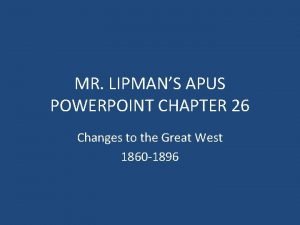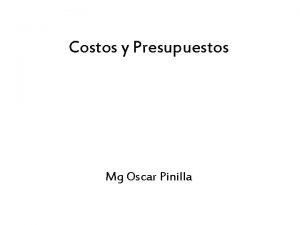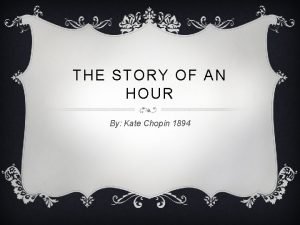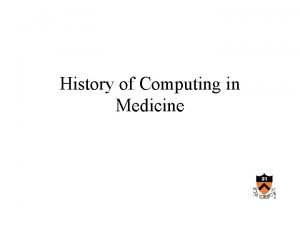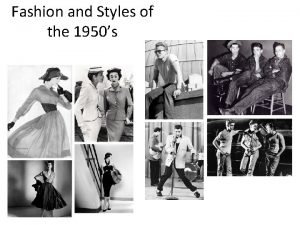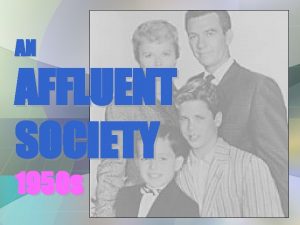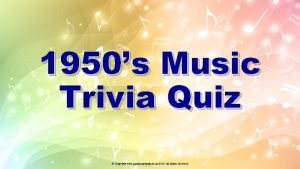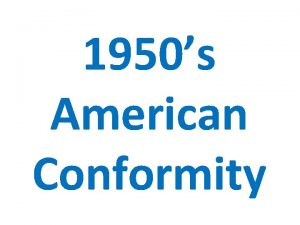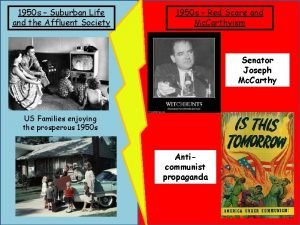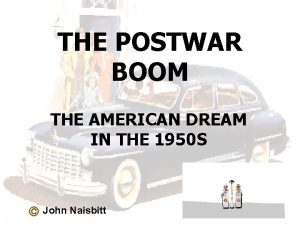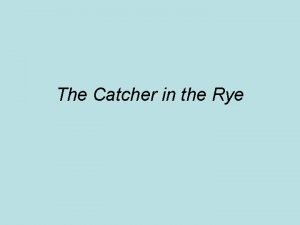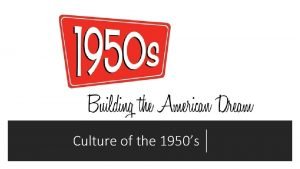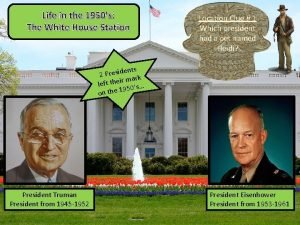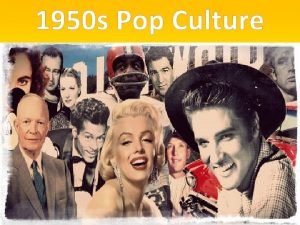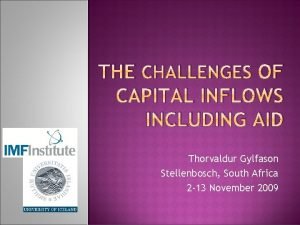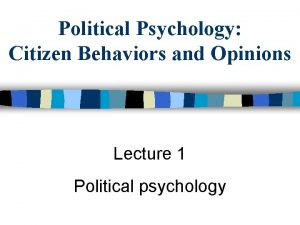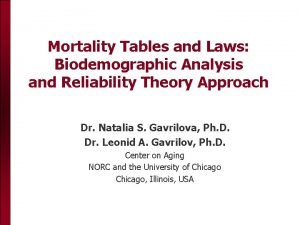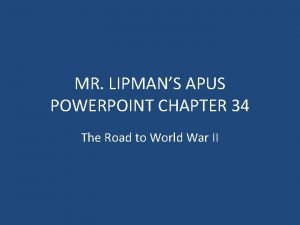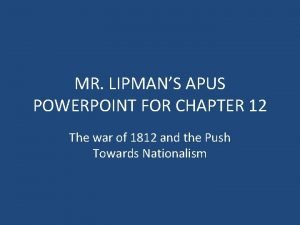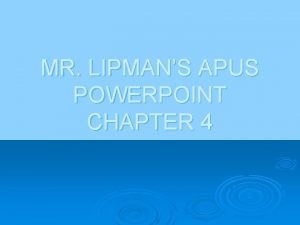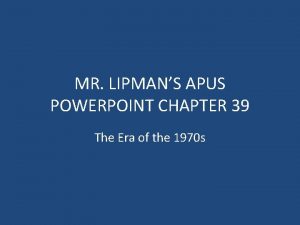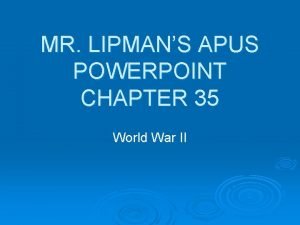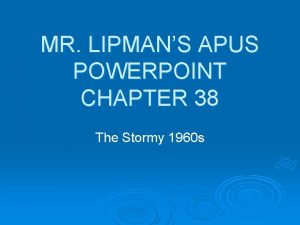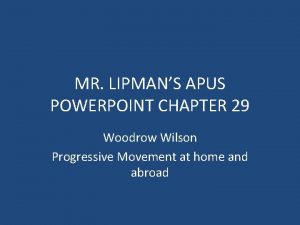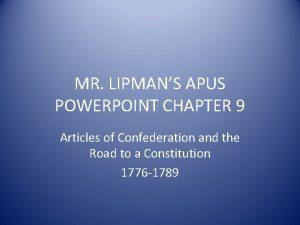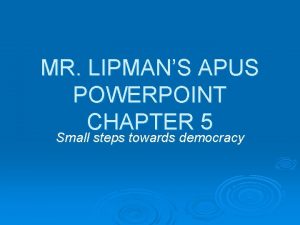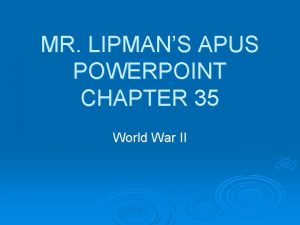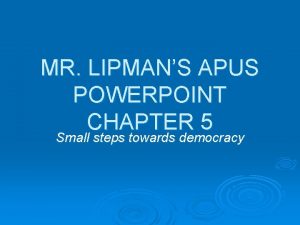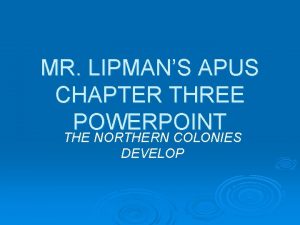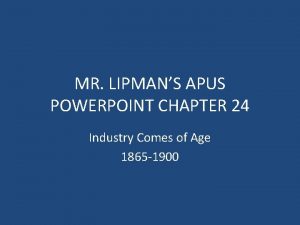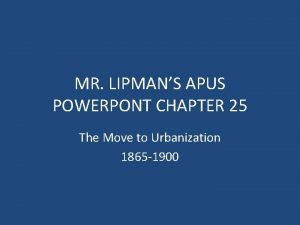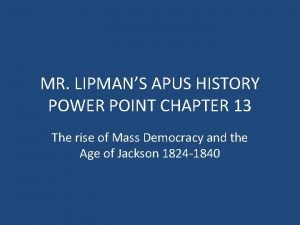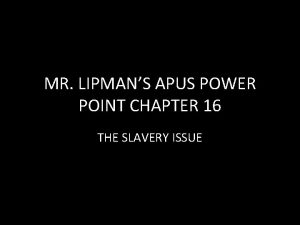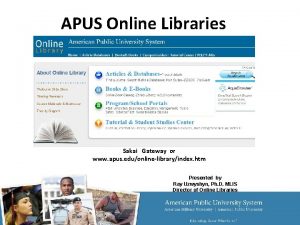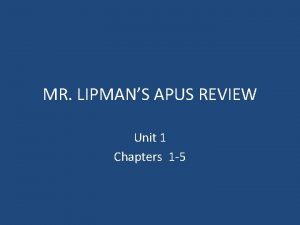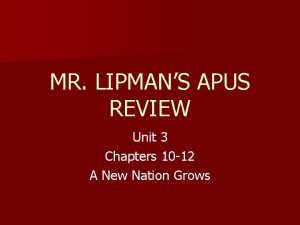MR LIPMANS APUS POWERPOINT CHAPTER 37 THE 1950s





































- Slides: 37

MR. LIPMAN’S APUS POWERPOINT CHAPTER 37 THE 1950’s

KEYS TO THE CHAPTER Ø Economic Prosperity Ø Mc. Carthyism Ø Civil Rights Era begins Ø Cold War Escalates Ø Space Race begins Ø Election of 1960

Economic Prosperity Ø Single Family Homes and Suburbs Ø Technology changes employment sector Ø Unions down & “white collar jobs” up Ø “Cult of Domesticity” returns for women Ø Women move into office employment

expansion of middle class and consumer culture l Easy credit, fast food, new forms of recreation • 1948 – first Mc. Donald’s • 1949 – first credit card • 1955 – Disneyland opened • Rock and Roll and Sex part of consumer culture

The Television Revolution

Ø Election of 1952 – Republicans l Nominate Dwight D. Eisenhower • General during WWII l Richard Nixon nominated as vice president Ø Election of 1952 – Democrats l l Weak because of Korea, Truman’s clashes with Mac. Arthur, inflation, seeming spread of communism Nominate Adlai Stevenson

Ø Nixon’s “Checkers Speech” l l Speech on national TV to confront $ allegations, made himself seem like a “regular guy” with a family and dog (Checkers) Will lose race for President in 1960 but come back from the dead and win presidency in 1968

Ø Senator Joseph Mc. Carthy {a quick rise and fall} l l Ø Elected in 1946 to US Senate from Wisconsin February 1950 – accused State Department of knowingly employing 205 Communist party members Failed to produce evidence of even 1 Americans believed communists infiltrating gov’t and initially approve of Mc. Carthy’s tactics Mc. Carthy and the Republicans l Eisenhower was afraid to confront Mc. Carthy, even though he disagreed with Mc. Carthy’s tactics

Mc. Carthy Making Accusations

Ø Spring of 1954 – Mc. Carthy attacked US Army l 35 days of televised hearings December 1954 – Senate censures him Ø 1957 – Mc. Carthy died of chronic alcoholism Ø Ø Effects of Mc. Carthyism l Mc. Carthyism – okays practice of publicizing accusations despite insufficient evidence l Damaged traditions of free speech l Careers of many ruined

Civil Rights Movement Begins Ø Life for blacks in the South in the 1950 s l l 15 million blacks lived in US and 2/3 rd in South Lived under segregation (Jim Crow laws) • Isolated from whites, economically & politically powerless • Separate schools, toilets, drinking fountains, restaurants, waiting rooms, train and bus seating 1947 Jackie Robinson breaks the baseball color barrier l 1950 – Sweatt v. Painter • Separate Professional schools ruled unequal

Ø 1954 – Brown v. Board of Education l Segregation in public schools was “inherently unequal” and therefore unconstitutional Decision reversed Plessy v. Ferguson (1896) Desegregation must occur “with all deliberate speed” l “massive resistance” in Deep South l l • 1956 -100 southern Congressman signed “Declaration of Constitutional Principles” pledging resistance to segregation • Some states used public money to set up private schools • 1964 – only 2% of eligible blacks in desegregated classes

It is only after the 1964 Civil Rights Act that actual desegregation begins in the schools

The Montgomery Bus Boycott -------December 1955 – January 1957

Ø 1957 – Congress passed first Civil Rights Act since Reconstruction l l Eisenhower is reluctant to act quickly Authorized federal injunctions (court orders) to protect voting rights 1957 – Southern Christian Leadership Conference (SCLC) 1957 - Little Rock, Arkansas confrontation

The “Little Rock Nine” Escorted by Federal Troops

“The Problem We All Live With”

Ø February 1, 1960 – “sit-ins” begin in Greensboro, North Carolina l l Four students demanded service at whites-only lunch counter in Woolworth’s and were refused End of the week – over 1, 000 students had joined sit-ins in Greensboro Sit-in movement then spread across South April 1960 – Student Nonviolent Coordinating Committee (SNCC, pronounced “snick”) begins

Ø IKE SPENDS BIG ON MILITARY DEFENSE AND THIS CREATES ECONOMIC PROSPERITY Ø Interstate Highway Act of 1956 l l l Public works project much bigger than New Deal $27 billion to build 42, 000 miles of interstates Effects • • Many new jobs Suburbanization of US Air quality problems and Increased energy consumption Railroads hurt by competition from trucks and cars

Defense Spending as a Percentage of GDP, 1950 - 1997

Ø Problems with “massive retaliation” l {more bang for the buck theory} l 1956 – Hungary rose in revolt against USSR • USSR used troops to put down rebellion • Revealed that nuclear weapons were overkill for a small incident like Hungary l l Long-range planes and nuclear weapons more expensive than Eisenhower first believed Fear of Nuclear War makes threats less believable against conventional weapons

Main US Highways, 1930 – 1970

Highway Construction in the 1950 s

The Vietnam Nightmare Begins Ø US helps France battle the nationalists l To oppose communism as well as gain French support for rearming of West Germany By 1954, US paying 80% of costs of French army Ø 1954 – French surrounded at Dienbienphu but Ike refuses to use bombers to help

-------Following 1954 Geneva Agreement that USA doesn’t sign --------17 th Parallel

Cold War Crises in the Middle East Ø The Suez crisis l October 1956 – Britain, France (with Israel) launch assault on Egypt but failed to tell IKE l Britain and France forced to withdraw l The Eisenhower Doctrine (1957) Military and economic aid promised to Middle Eastern nations threatened by communist aggression OPEC is formed in 1960 and becomes a power in 1970 s when it cuts off oil exports

Sputnik I and Sputnik II 1957 The Race is On

Ø Effects of Sputnik l Ø American superiority in science, military, and education questioned and NASA established l 1958 – US put satellite in orbit l By 1960, US had developed its own ICBMs US education criticized for being too easy l Drive to replace electives with math and science courses

Federal gov’t gets involved in Education

Ø U-2 incident May 1, 1960 l Gary Powers (CIA pilot) shot down while spying in Soviet airspace • US denied he was spying, but USSR brought out proof l l Summit ruined when Khrushchev stormed out Tensions remain high between countries and now Cuba becomes a problem

Ø The Cuban Revolution l l l January 1959 – Fidel Castro carried out revolution and deposed Batista Castro seizes property from Americans to carry out land distribution Castro allied with USSR when US cut off sugar imports • US threatened to enforce Monroe Doctrine, but did not when Khrushchev threatened war

Nixon and Kennedy Debate: Election 1960

Ø Election of 1960 – results l Kennedy won, narrowly • Margin of only 118, 574 votes (out of 68 million cast) {“the Chicago factor”? } • First Roman Catholic, and youngest ever elected • Received strong support in big cities, from workers, Catholics, blacks l Democrats won both houses of Congress

Ø Accomplishments under Eisenhower l US was extremely prosperous • With pockets of poverty and some farm problems l l Some Civil Rights victories (but hated Warren pick) Controlled military through decade with USSR • Warned of “military-industrial complex” in farewell address in 1961 l Reality was Eisenhower a strong president despite critics; gained greater reputation as time has passes

POST WAR LITERATURE Ø In fiction, some prewar realists continued l l l Ernest Hemingway: The Old Man and the Sea (1952); killed himself in 1961 John Steinbeck: East of Eden (1952) and Travels with Charley (1962); Norman Mailer: The Naked and the Dead Joseph Heller: Catch-22 Kurt Vonnegut: Slaughterhouse 5

Post War Playwrights Tennessee Williams wrote of psychological misfits trying to hold it together in modern life • A Streetcar Named Desire; Cat on a Hot Tin Roof l Arthur Miller’s plays about American values • Death of a Salesman (1949); The Crucible (1953) l l Lorraine Hansberry: A Raisin in the Sun Edward Albee: Who’s Afraid of Virginia Woolf? (1962) • exposed the darker side of middle-class life

Ø Bestselling books by black authors l l l Richard Wright: Native Son (1940) Ralph Ellison: Invisible Man (1952) about blacks’ search for identity James Baldwin: The Fire Next Time (1963) explored racial questions
 Lipmans party store
Lipmans party store Estructura de un presupuesto ejemplo
Estructura de un presupuesto ejemplo Puma deviate
Puma deviate Apu linli significado
Apu linli significado 1950s home economics textbook
1950s home economics textbook Computers in the 1950
Computers in the 1950 1950s fashin
1950s fashin Concept cars 1950s
Concept cars 1950s The affluent society 1950s
The affluent society 1950s 50s music trivia questions and answers
50s music trivia questions and answers Hugh hefner
Hugh hefner Suburban life 1950s
Suburban life 1950s 1950s conformity and counterculture
1950s conformity and counterculture Conglomerates and franchises 1950s
Conglomerates and franchises 1950s Cost of living 1958
Cost of living 1958 Daily life and popular culture in the 1950s
Daily life and popular culture in the 1950s Mass media 1950s
Mass media 1950s What groups were experiencing poverty in the 1950’s?
What groups were experiencing poverty in the 1950’s? Beat writers 1950s
Beat writers 1950s 1950s beatnik fashion
1950s beatnik fashion School punishments in the 1950s
School punishments in the 1950s Color tv started
Color tv started Trends of 1950s
Trends of 1950s Trends of 1950s
Trends of 1950s Trends of 1950s
Trends of 1950s Trends of 1950s
Trends of 1950s Language
Language Red scare 1950s
Red scare 1950s Hình ảnh bộ gõ cơ thể búng tay
Hình ảnh bộ gõ cơ thể búng tay Ng-html
Ng-html Bổ thể
Bổ thể Tỉ lệ cơ thể trẻ em
Tỉ lệ cơ thể trẻ em Chó sói
Chó sói Chụp tư thế worms-breton
Chụp tư thế worms-breton Bài hát chúa yêu trần thế alleluia
Bài hát chúa yêu trần thế alleluia Môn thể thao bắt đầu bằng từ đua
Môn thể thao bắt đầu bằng từ đua Thế nào là hệ số cao nhất
Thế nào là hệ số cao nhất Các châu lục và đại dương trên thế giới
Các châu lục và đại dương trên thế giới
